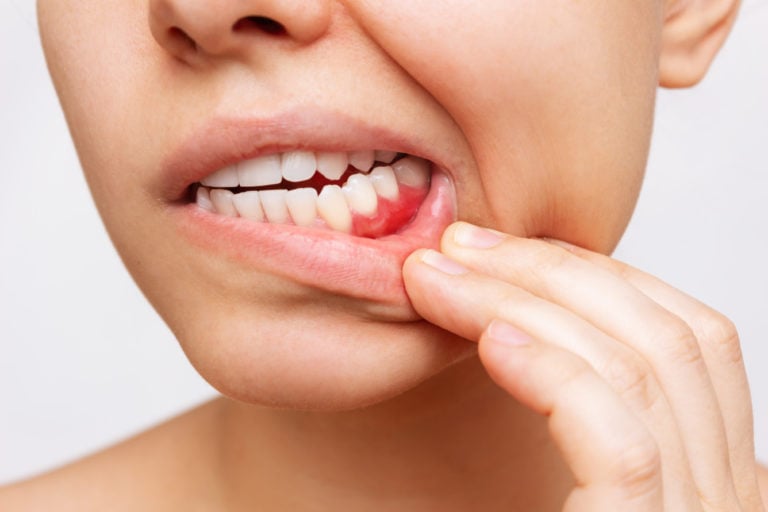Have you ever experienced how suddenly and without prior pain a tooth moves or even falls out? You may be suffering from periodontitis or gum disease without knowing it. If you want to know what it consists of and how to prevent and treat it, keep reading.
Currently, the term “pyorrhea” is obsolete in dentistry, but perhaps many of you have heard it over the years. The word “pyorrhea” is still commonly used to refer to gum disease, although the term we currently use in dentistry to refer to it is “periodontitis.”
Pyorrhea or periodontitis is an infectious disease and the main cause of tooth loss along with cavities. Its great danger lies in the fact that it is a disease that does not cause excessive pain or too severe discomfort, so it often goes unnoticed or is easily normalized.
It is a chronic inflammatory condition of the tissue surrounding our teeth, resulting in progressive destruction of the periodontal ligament and the alveolar bone that supports our teeth.
The main difference from gingivitis is that gingivitis involves inflammation of the gums but does not involve bone destruction, whereas periodontitis or pyorrhea does involve bone destruction.
When periodontal pockets form, which are an accumulation of bacteria below the gum line, their action causes damage to dental structures, leading to the deterioration of the bone supporting our teeth.
Why does periodontitis occur?
As we mentioned, being an infectious disease, the main cause of its appearance is the accumulation of bacterial plaque due to poor oral hygiene. If we do not correctly remove this plaque, we will cause inflammation of our gums in the short term and hardening over time, adhering to our teeth and forming what we call tartar (calculus), which once attached to the tooth, we will not be able to remove it with conventional brushing and will require professional dental hygiene.
How can we know if we have periodontitis?
To detect if we are suffering from periodontitis, the most common symptoms are gum inflammation and a change in its color, becoming reddish or violet. Of course, another clear symptom is bleeding gums when brushing, bad breath, discomfort when chewing, or noticing that some teeth are loose.
Sometimes spaces between the teeth may also appear, and in some cases, abscesses or overgrowth in the gums. But undoubtedly, bleeding is the first warning sign. Bleeding gums do not directly mean that we have pyorrhea; it could be gingivitis. However, it will serve as an alert for us to immediately consult our specialist for a correct diagnosis and intervention before the disease progresses to a more severe stage.
What are the risk factors?
Any of us can suffer from periodontitis if we do not take proper care of ourselves, but there are certain risk factors that can accelerate the disease or simply increase the risk of suffering from it.
Chronic gingivitis, smoking, hormonal changes in women such as pregnancy or menopause, old age, substance abuse, lack of vitamin C, or diseases that weaken our defenses (diabetes, arthritis, Crohn’s disease, leukemia, HIV, oncological treatments). In these cases, prevention should be even more thorough to avoid future complications.
Periodontitis Treatment
As we have already mentioned, the main cause of periodontitis is poor oral hygiene, so the key to stopping the appearance or progression of the disease will undoubtedly be to have proper oral hygiene.
Periodontal disease can lead to serious consequences for our health, so it is important to detect it as soon as possible to be able to treat it and prevent it from becoming chronic.
The first step is to establish a clear diagnosis elaborated by a professional, to assess what our best options are and find a solution adapted to our needs.
Once diagnosed, we can make a prognosis for our teeth and
realize a treatment plan tailored to our needs. It usually starts with deep dental hygiene to remove calculus adhered to our teeth and below the gums.
And from there, the key factor will be to correct our poor hygiene habits as soon as possible and maintain proper maintenance by our specialist, attending regular check-ups as recommended. We will have to learn to correctly use our toothbrush, use dental floss and interdental brushes to complete our daily hygiene, and visit our dentist regularly to take care of the residues we cannot reach.
We must bear in mind that periodontitis is a chronic disease, so once diagnosed, maintenance visits for professional hygiene should be regular to halt its progression. A professional cleaning every 3, 4, or 6 months is recommended depending on each patient’s needs.
